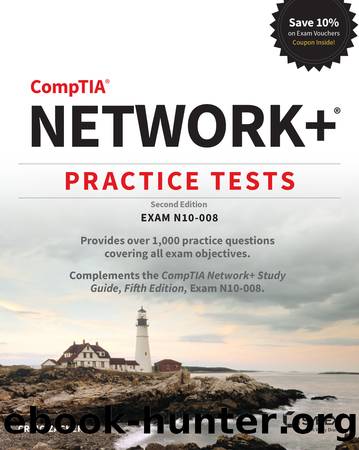CompTIA Network+ Practice Tests by Zacker Craig;

Author:Zacker, Craig; [Zacker, Craig]
Language: eng
Format: epub
Publisher: John Wiley & Sons, Incorporated
Published: 2021-10-26T00:00:00+00:00
B. In a private cloud, the same organization that utilizes the cloud services can also be the sole owner of the infrastructure that provides those services. A private cloud can also be owned by a third party, all or in part. In the public cloud model, one organization functions as the provider, and another organization consumes the services of the provider. A hybrid cloud is a combination of public and private infrastructure so that the consumer organization is only a partial owner of the infrastructure. There is no such thing as an ad hoc cloud model.
B. Cloud bursting is a common term for the offloading of excess traffic from private to public cloud resources when necessary to maintain satisfactory performance levels.
C. Software as a Service (SaaS) provides consumers with access to a specific application running on the provider's servers (in this case, an email service). Consumers have control over some of their email functions, but they have no control over the operating system, the servers, or the underlying resources. The Infrastructure as a Service (IaaS) model provides the consumers with access to processing, storage, and networking resources that the consumer can use as needed. Platform as a Service (PaaS) provides consumers with the ability to install applications of their choice on a server furnished by the provider. Desktop as a Service (DaaS) provides remote virtualization of the entire workstation desktop, instead of a single application.
C. A hybrid cloud consists of both public and private resources. One of its main advantages is that administrators can move services from private to public cloud servers and back again as needed, depending on the current workload. Public cloud resources require authentication, so while they might be less secure than a private cloud, they are not inherently insecure. The term private cloud refers to hardware resources that are owned and operated either by a single organization or a third party, regardless of their location. The various cloud delivery models do not impose specific hardware resource requirements.
B. The Platform as a Service (PaaS) model provides consumers with the ability to install applications of their choice on a server furnished by the provider. Infrastructure as a Service (IaaS) provides the consumers with processing, storage, and networking resources that they can use to install and run operating systems and other software of their choice. Software as a Service (SaaS) provides consumers with access to a specific application running on the provider's servers. Desktop as a Service (DaaS) provides remote virtualization of the entire workstation desktop, instead of a single application.
A, B, C. Multitenancy is a software architecture in which multiple tenants share a single instance of an application running in the cloud. Because tenants share a single application, there is a chance that data could be compromised. Because a single application instance is running in the cloud, the operational overhead is reduced compared to the use of individual virtual machines. Tenants share a finite amount of bandwidth, so the possibility exists for competition to occur, such as when one tenant is the target of a Denial of Service (DoS) attack.
Download
This site does not store any files on its server. We only index and link to content provided by other sites. Please contact the content providers to delete copyright contents if any and email us, we'll remove relevant links or contents immediately.
Exploring Deepfakes by Bryan Lyon and Matt Tora(7708)
Robo-Advisor with Python by Aki Ranin(7606)
Offensive Shellcode from Scratch by Rishalin Pillay(6094)
Microsoft 365 and SharePoint Online Cookbook by Gaurav Mahajan Sudeep Ghatak Nate Chamberlain Scott Brewster(5003)
Ego Is the Enemy by Ryan Holiday(4954)
Management Strategies for the Cloud Revolution: How Cloud Computing Is Transforming Business and Why You Can't Afford to Be Left Behind by Charles Babcock(4438)
Python for ArcGIS Pro by Silas Toms Bill Parker(4173)
Elevating React Web Development with Gatsby by Samuel Larsen-Disney(3875)
Machine Learning at Scale with H2O by Gregory Keys | David Whiting(3611)
Learning C# by Developing Games with Unity 2021 by Harrison Ferrone(3284)
Speed Up Your Python with Rust by Maxwell Flitton(3231)
Liar's Poker by Michael Lewis(3220)
OPNsense Beginner to Professional by Julio Cesar Bueno de Camargo(3195)
Extreme DAX by Michiel Rozema & Henk Vlootman(3169)
Agile Security Operations by Hinne Hettema(3122)
Linux Command Line and Shell Scripting Techniques by Vedran Dakic and Jasmin Redzepagic(3108)
Essential Cryptography for JavaScript Developers by Alessandro Segala(3081)
Cryptography Algorithms by Massimo Bertaccini(3001)
AI-Powered Commerce by Andy Pandharikar & Frederik Bussler(2981)
